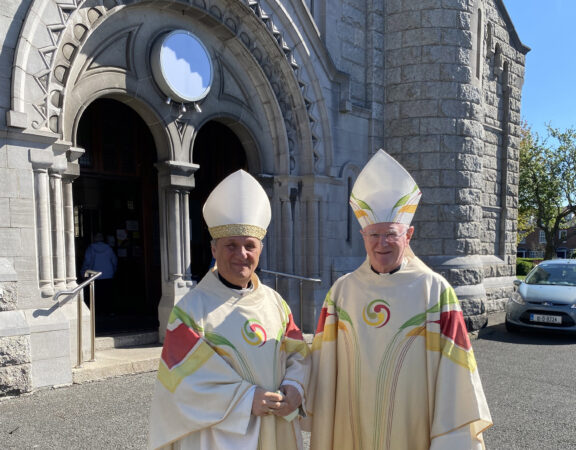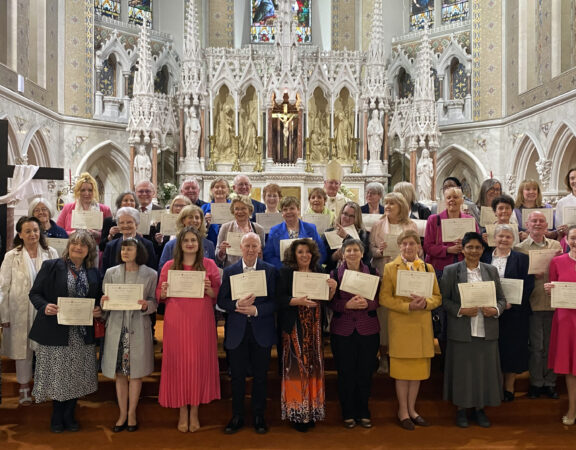Family and Mission Day Eucharist
100 YEARS OF COLUMBAN MISSION
Homily notes of Most Rev. Diarmuid Martin, Archbishop of Dublin
Saint Colomban’s Dalgan Park, Navan, 1st July 2018
On 29 June 1918, one hundred years ago almost to the day, the idea of setting-up a missionary society of Irish diocesan priests was approved by the Bishops of Ireland and what was then called the Maynooth Mission to China was born.
One hundred years later, we gather to celebrate a century of mission of a Columban movement that has spread around the world and has undertaken new areas of activity. It has become a world-wide spiritual and missionary movement embracing priests, religious sisters and lay missionaries, inserted into a wider movement of individuals and families who support and are enriched by the Columban tradition.
You will find Columbans in many parts of the world. Yes, in China, but also in Korea, Burma, and the Philippines and in other parts of Asia, in Latin America and here in Europe. I think of the contribution of the Columbans to the coordination of Irish emigrant chaplaincy in Britain in the 1950’s and 1960’s and as Archbishop of Dublin of the generous work of Columban priests and sisters in the parish of Balcurris in Ballymun.
Travel the world and wherever you find Columbans and there will be two words that will inevitably emerge: mission and the poor. The Columban tradition has been one that embraces a unified mission of preaching the name of Jesus, caring for the poor and addressing the root causes of poverty and damage to God’s creation.
Dalgan Park became a household name in Ireland. It became a place of pilgrimage for leaders of the Church from different parts of the world who came to visit Ireland. The Church owes a debt of gratitude to this great tradition. The Church in Ireland has every reason be proud of this tradition.
Dalgan may have changed from the flourishing seminary that it was at the time I was to enter the seminary in Dublin. Today, it is a home to many retired priests who had given years and years of service. We are proud here today to remember their contribution. They have every reason to be proud of how they have won our recognition and affection for what they did.
As we look back over these hundred years, we think especially of those who gave their life in the service of the Gospel, especially those Irish priests listed among the Korean Martyrs.
Reflecting on the invitation I received to celebrate this Jubilee Mass, I kept asking myself what it was it in 1918 that gave rise to this new vigour in the Irish missionary tradition.
The Ireland of 1918 was a difficult and uncertain time. Our insecurity today about Brexit fades into the shade with the uncertainty and insecurity that existed in Ireland in June 1918. It was only two years after 1916. The horror of First World War had not yet ended. Ireland was divided. Negotiations regarding future independence were underway but still uncertain. The possibility for the first time of a border on the island of Ireland lurked on the horizon. Economically, Ireland was at its poorest, both in urban and rural communities.
It is remarkable that at that moment a group of priests in Maynooth would have come up with such a far-seeing sense of what mission means. We have to learn the lesson that renewal in the Church comes when the Church rises above being locked within its own cares and rediscovers its call to reach out and be missionary.
Again, we have to think of an Ireland of 1918 without the means of communication that exist today. What did China mean to those founders? How much did they know about Chine? The Columban tradition is not just one of not being trapped in the local but also of having the courage to reach out into the world of uncertainty and the unknown.
What should we learn from that courage of the founders of the Columban family?
The crisis of the Irish Church is more than about of a lack of vocations. The bigger crisis is that of the growing alienation between young people and the Church and indeed the growing distance between young people and the relevance of the teaching of Jesus Christ.
Numbers attending Mass are down right across Ireland. People are struck when they go to Mass in a parish at which there is a substantial presence of young people or young families.
Priests find it hard to communicate with young people about religious matters. The same is true of Christian parents who day after day struggle in seeking to transmit something of their own sense of faith and prayer to their children. Yet they are truly proud of the great sense of idealism and goodness, of justice and care of their children
I am very happy that this celebration of Columban Mission should be inserted into the preparation of the World Meeting of Families that will be celebrated in Dublin in less than two months’ time. Perhaps it would be better to say that this Mission Day celebration is inserted into a new drive to restore confidence in the family as a way to transmit the faith.
One of the marks of the Columban tradition is that of a sense of solidarity with the families of missionaries and with a sense of support for the missionaries among Irish families. The Far East became a household name. Not quite the New York Times it was however a wonderful support and affection for the Columban missionary tradition.
Today we have to come back to that sense of not being trapped in the crisis of the moment and dreaming again of an openness to being truly missionary disciples. The message of Jesus is always a message that challenges us to rise above conformity. Let us look again at the two central figures in the Gospel reading we have just heard.
The first is the man, Jairus, a synagogue official. He was a man who had an official role within the believing community. He would have been expected to maintain a distance and suspicion indeed even hostility towards Jesus. Yet, Jairus realised that there were certain things that were more important to him and to Jesus than the narrow norms and customs of the day. For Jairus, Jesus was the one who could heal and bring life. For Jesus, healing and restoring life were more important than narrow norms and customs.
Then there is the woman who had suffered from the haemorrhage for many years. This woman was considered unclean. Within a society that tried to keep her out of view, she saw one hope: Jesus. She had only heard of Jesus and yet her faith gave her the courage to approach him. She touches just the hem of his garment and she was instantly cured.
What does Jesus do? He stops and asks who it was that had touched him. The woman is embarrassed. She could be condemned by the norms and customs of the day for even touching Jesus. Jesus himself, according to those same customs, would have become impure because he had been touched by impurity. Jesus simply assures the woman that she has been healed and should now go and live in peace.
Jesus heals. He tells those who have witnessed his healing that they are not to talk about it. His desire in healing is to restore the dignity and the everyday life of the person healed: the woman should live now in peace and the child who was cured should simply be given something to eat.
We celebrate 100 years of Columban missionary tradition. Just as in 1918 we pray for a Church and a Columban missionary tradition that can today rise out of narrow preoccupation with self and reach out to answer the call to bring the message of the loving kindness of God to a world often so harsh.
One word that I have used throughout these reflections was “affection”. Irish Catholics have a special affection for the Columbans. One witness to that affection is the only writing we have from Matt Talbot. It was a handwritten – hand scribbled – note of a small donation from “a poor man Matthew Talbot”. That affection for the Columbans is still alive and well and is clearly visible here today.ENDS









